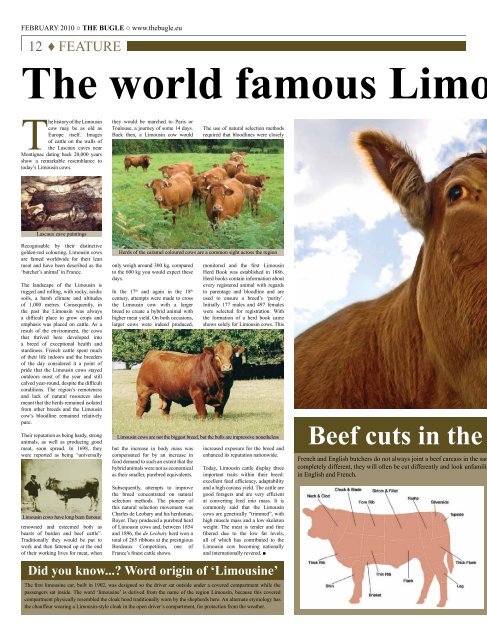Creuse is still the safest place to live in France - The Bugle
Creuse is still the safest place to live in France - The Bugle
Creuse is still the safest place to live in France - The Bugle
Create successful ePaper yourself
Turn your PDF publications into a flip-book with our unique Google optimized e-Paper software.
FEBRUARY 2010 ○ THE BUGLE ○ www.<strong>the</strong>bugle.eu<br />
12 ♦ FEATURE<br />
<strong>The</strong> world famous Limo<br />
<strong>The</strong> h<strong>is</strong><strong>to</strong>ry of <strong>the</strong> Limous<strong>in</strong><br />
cow may be as old as<br />
Europe itself. Images<br />
of cattle on <strong>the</strong> walls of<br />
<strong>the</strong> Lascaux caves near<br />
Montignac dat<strong>in</strong>g back 20,000 years<br />
show a remarkable resemblance <strong>to</strong><br />
<strong>to</strong>day’s Limous<strong>in</strong> cows.<br />
<strong>the</strong>y would be marched <strong>to</strong> Par<strong>is</strong> or<br />
Toulouse, a journey of some 14 days.<br />
Back <strong>the</strong>n, a Limous<strong>in</strong> cow would<br />
<strong>The</strong> use of natural selection methods<br />
required that bloodl<strong>in</strong>es were closely<br />
Lascaux cave pa<strong>in</strong>t<strong>in</strong>gs<br />
Recogn<strong>is</strong>able by <strong>the</strong>ir d<strong>is</strong>t<strong>in</strong>ctive<br />
golden-red colour<strong>in</strong>g, Limous<strong>in</strong> cows<br />
are famed worldwide for <strong>the</strong>ir lean<br />
meat and have been described as <strong>the</strong><br />
‘butcher’s animal’ <strong>in</strong> <strong>France</strong>.<br />
<strong>The</strong> landscape of <strong>the</strong> Limous<strong>in</strong> <strong>is</strong><br />
rugged and roll<strong>in</strong>g, with rocky, acidic<br />
soils, a harsh climate and altitudes<br />
of 1,000 metres. Consequently, <strong>in</strong><br />
<strong>the</strong> past <strong>the</strong> Limous<strong>in</strong> was always<br />
a difficult <strong>place</strong> <strong>to</strong> grow crops and<br />
emphas<strong>is</strong> was <strong>place</strong>d on cattle. As a<br />
result of <strong>the</strong> environment, <strong>the</strong> cows<br />
that thrived here developed <strong>in</strong><strong>to</strong><br />
a breed of exceptional health and<br />
sturd<strong>in</strong>ess. French cattle spent much<br />
of <strong>the</strong>ir life <strong>in</strong>doors and <strong>the</strong> breeders<br />
of <strong>the</strong> day considered it a po<strong>in</strong>t of<br />
pride that <strong>the</strong> Limous<strong>in</strong> cows stayed<br />
outdoors most of <strong>the</strong> year and <strong>still</strong><br />
calved year-round, despite <strong>the</strong> difficult<br />
conditions. <strong>The</strong> region’s remoteness<br />
and lack of natural resources also<br />
meant that <strong>the</strong> herds rema<strong>in</strong>ed <strong>is</strong>olated<br />
from o<strong>the</strong>r breeds and <strong>the</strong> Limous<strong>in</strong><br />
cow’s bloodl<strong>in</strong>e rema<strong>in</strong>ed relatively<br />
pure.<br />
<strong>The</strong>ir reputation as be<strong>in</strong>g hardy, strong<br />
animals, as well as produc<strong>in</strong>g good<br />
meat, soon spread. In 1698, <strong>the</strong>y<br />
were reported as be<strong>in</strong>g “universally<br />
Limous<strong>in</strong> cows have long been famous<br />
renowned and esteemed both as<br />
beasts of burden and beef cattle”.<br />
Traditionally <strong>the</strong>y would be put <strong>to</strong><br />
work and <strong>the</strong>n fattened up at <strong>the</strong> end<br />
of <strong>the</strong>ir work<strong>in</strong>g <strong>live</strong>s for meat, when<br />
Herds of <strong>the</strong> caramel coloured cows are a common sight across <strong>the</strong> region<br />
only weigh around 300 kg, compared<br />
<strong>to</strong> <strong>the</strong> 600 kg you would expect <strong>the</strong>se<br />
days.<br />
In <strong>the</strong> 17 th and aga<strong>in</strong> <strong>in</strong> <strong>the</strong> 18 th<br />
century, attempts were made <strong>to</strong> cross<br />
<strong>the</strong> Limous<strong>in</strong> cow with a larger<br />
breed <strong>to</strong> create a hybrid animal with<br />
higher meat yield. On both occasions,<br />
larger cows were <strong>in</strong>deed produced,<br />
but <strong>the</strong> <strong>in</strong>crease <strong>in</strong> body mass was<br />
compensated for by an <strong>in</strong>crease <strong>in</strong><br />
food demand <strong>to</strong> such an extent that <strong>the</strong><br />
hybrid animals were not as economical<br />
as <strong>the</strong>ir smaller, purebred equivalents.<br />
Subsequently, attempts <strong>to</strong> improve<br />
<strong>the</strong> breed concentrated on natural<br />
selection methods. <strong>The</strong> pioneer of<br />
th<strong>is</strong> natural selection movement was<br />
Charles de Leobary and h<strong>is</strong> herdsman,<br />
Royer. <strong>The</strong>y produced a purebred herd<br />
of Limous<strong>in</strong> cows and, between 1854<br />
and 1896, <strong>the</strong> de Leobary herd won a<br />
<strong>to</strong>tal of 265 ribbons at <strong>the</strong> prestigious<br />
Bordeaux Competition, one of<br />
<strong>France</strong>’s f<strong>in</strong>est cattle shows.<br />
moni<strong>to</strong>red and <strong>the</strong> first Limous<strong>in</strong><br />
Herd Book was establ<strong>is</strong>hed <strong>in</strong> 1886.<br />
Herd books conta<strong>in</strong> <strong>in</strong>formation about<br />
every reg<strong>is</strong>tered animal with regards<br />
<strong>to</strong> parentage and bloodl<strong>in</strong>e and are<br />
used <strong>to</strong> ensure a breed’s ‘purity’.<br />
Initially 177 males and 497 females<br />
were selected for reg<strong>is</strong>tration. With<br />
<strong>the</strong> formation of a herd book came<br />
shows solely for Limous<strong>in</strong> cows. Th<strong>is</strong><br />
Limous<strong>in</strong> cows are not <strong>the</strong> biggest breed, but <strong>the</strong> bulls are impressive none<strong>the</strong>less<br />
<strong>in</strong>creased exposure for <strong>the</strong> breed and<br />
enhanced its reputation nationwide.<br />
Today, Limous<strong>in</strong> cattle d<strong>is</strong>play three<br />
important traits with<strong>in</strong> <strong>the</strong>ir breed:<br />
excellent feed efficiency, adaptability<br />
and a high carcass yield. <strong>The</strong> cattle are<br />
good foragers and are very efficient<br />
at convert<strong>in</strong>g feed <strong>in</strong><strong>to</strong> mass. It <strong>is</strong><br />
commonly said that <strong>the</strong> Limous<strong>in</strong><br />
cows are genetically “trimmed”, with<br />
high muscle mass and a low skele<strong>to</strong>n<br />
weight. <strong>The</strong> meat <strong>is</strong> tender and f<strong>in</strong>e<br />
fibered due <strong>to</strong> <strong>the</strong> low fat levels,<br />
all of which has contributed <strong>to</strong> <strong>the</strong><br />
Limous<strong>in</strong> cow becom<strong>in</strong>g nationally<br />
and <strong>in</strong>ternationally revered. ■<br />
Did you know... Word orig<strong>in</strong> of ‘Limous<strong>in</strong>e’<br />
<strong>The</strong> first limous<strong>in</strong>e car, built <strong>in</strong> 1902, was designed so <strong>the</strong> driver sat outside under a covered compartment while <strong>the</strong><br />
passengers sat <strong>in</strong>side. <strong>The</strong> word ‘limous<strong>in</strong>e’ <strong>is</strong> derived from <strong>the</strong> name of <strong>the</strong> region Limous<strong>in</strong>, because th<strong>is</strong> covered<br />
compartment physically resembled <strong>the</strong> cloak hood traditionally worn by <strong>the</strong> shepherds here. An alternate etymology has<br />
<strong>the</strong> chauffeur wear<strong>in</strong>g a Limous<strong>in</strong>-style cloak <strong>in</strong> <strong>the</strong> open driver’s compartment, for protection from <strong>the</strong> wea<strong>the</strong>r.<br />
Beef cuts <strong>in</strong> <strong>the</strong><br />
French and Engl<strong>is</strong>h butchers do not always jo<strong>in</strong>t a beef carcass <strong>in</strong> <strong>the</strong> sam<br />
completely different, <strong>the</strong>y will often be cut differently and look unfamilia<br />
<strong>in</strong> Engl<strong>is</strong>h and French.
















